transmission oil Ram 3500 2017 Diesel Supplement
[x] Cancel search | Manufacturer: RAM, Model Year: 2017, Model line: 3500, Model: Ram 3500 2017Pages: 228, PDF Size: 1.35 MB
Page 13 of 228
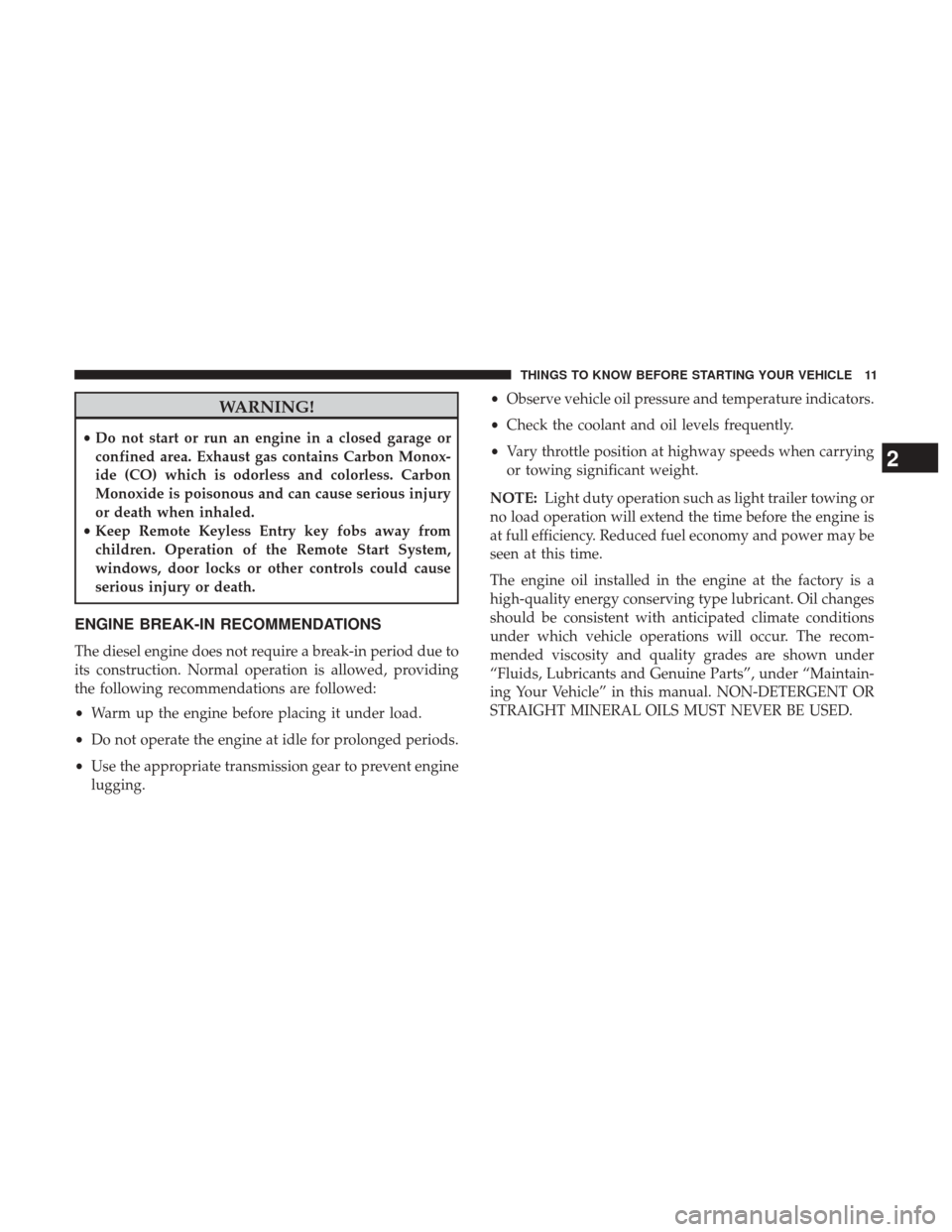
WARNING!
•Do not start or run an engine in a closed garage or
confined area. Exhaust gas contains Carbon Monox-
ide (CO) which is odorless and colorless. Carbon
Monoxide is poisonous and can cause serious injury
or death when inhaled.
• Keep Remote Keyless Entry key fobs away from
children. Operation of the Remote Start System,
windows, door locks or other controls could cause
serious injury or death.
ENGINE BREAK-IN RECOMMENDATIONS
The diesel engine does not require a break-in period due to
its construction. Normal operation is allowed, providing
the following recommendations are followed:
• Warm up the engine before placing it under load.
• Do not operate the engine at idle for prolonged periods.
• Use the appropriate transmission gear to prevent engine
lugging. •
Observe vehicle oil pressure and temperature indicators.
• Check the coolant and oil levels frequently.
• Vary throttle position at highway speeds when carrying
or towing significant weight.
NOTE: Light duty operation such as light trailer towing or
no load operation will extend the time before the engine is
at full efficiency. Reduced fuel economy and power may be
seen at this time.
The engine oil installed in the engine at the factory is a
high-quality energy conserving type lubricant. Oil changes
should be consistent with anticipated climate conditions
under which vehicle operations will occur. The recom-
mended viscosity and quality grades are shown under
“Fluids, Lubricants and Genuine Parts”, under “Maintain-
ing Your Vehicle” in this manual. NON-DETERGENT OR
STRAIGHT MINERAL OILS MUST NEVER BE USED.
2
THINGS TO KNOW BEFORE STARTING YOUR VEHICLE 11
Page 29 of 228
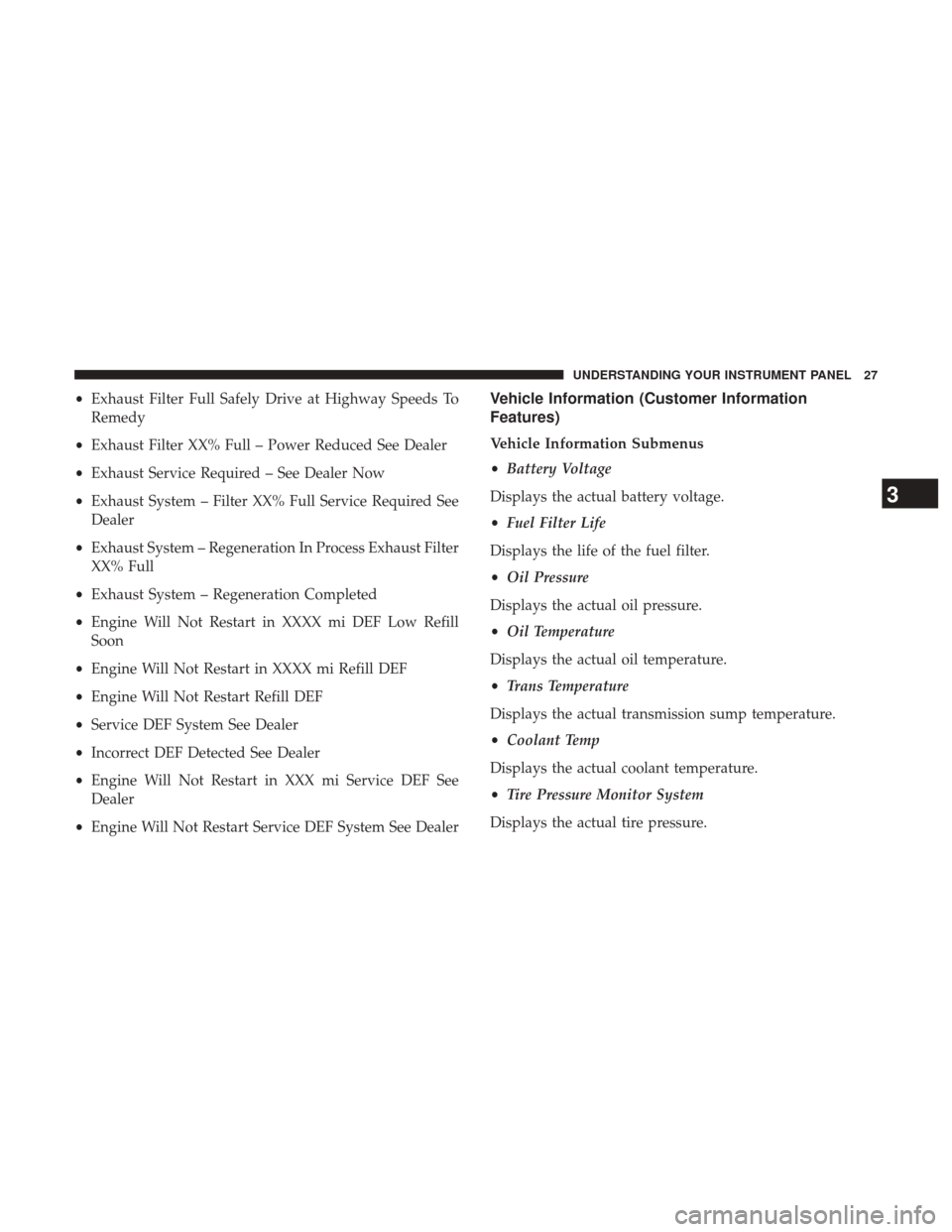
•Exhaust Filter Full Safely Drive at Highway Speeds To
Remedy
• Exhaust Filter XX% Full – Power Reduced See Dealer
• Exhaust Service Required – See Dealer Now
• Exhaust System – Filter XX% Full Service Required See
Dealer
• Exhaust System – Regeneration In Process Exhaust Filter
XX% Full
• Exhaust System – Regeneration Completed
• Engine Will Not Restart in XXXX mi DEF Low Refill
Soon
• Engine Will Not Restart in XXXX mi Refill DEF
• Engine Will Not Restart Refill DEF
• Service DEF System See Dealer
• Incorrect DEF Detected See Dealer
• Engine Will Not Restart in XXX mi Service DEF See
Dealer
• Engine Will Not Restart Service DEF System See DealerVehicle Information (Customer Information
Features)
Vehicle Information Submenus
•Battery Voltage
Displays the actual battery voltage.
• Fuel Filter Life
Displays the life of the fuel filter.
• Oil Pressure
Displays the actual oil pressure.
• Oil Temperature
Displays the actual oil temperature.
• Trans Temperature
Displays the actual transmission sump temperature.
• Coolant Temp
Displays the actual coolant temperature.
• Tire Pressure Monitor System
Displays the actual tire pressure.
3
UNDERSTANDING YOUR INSTRUMENT PANEL 27
Page 39 of 228
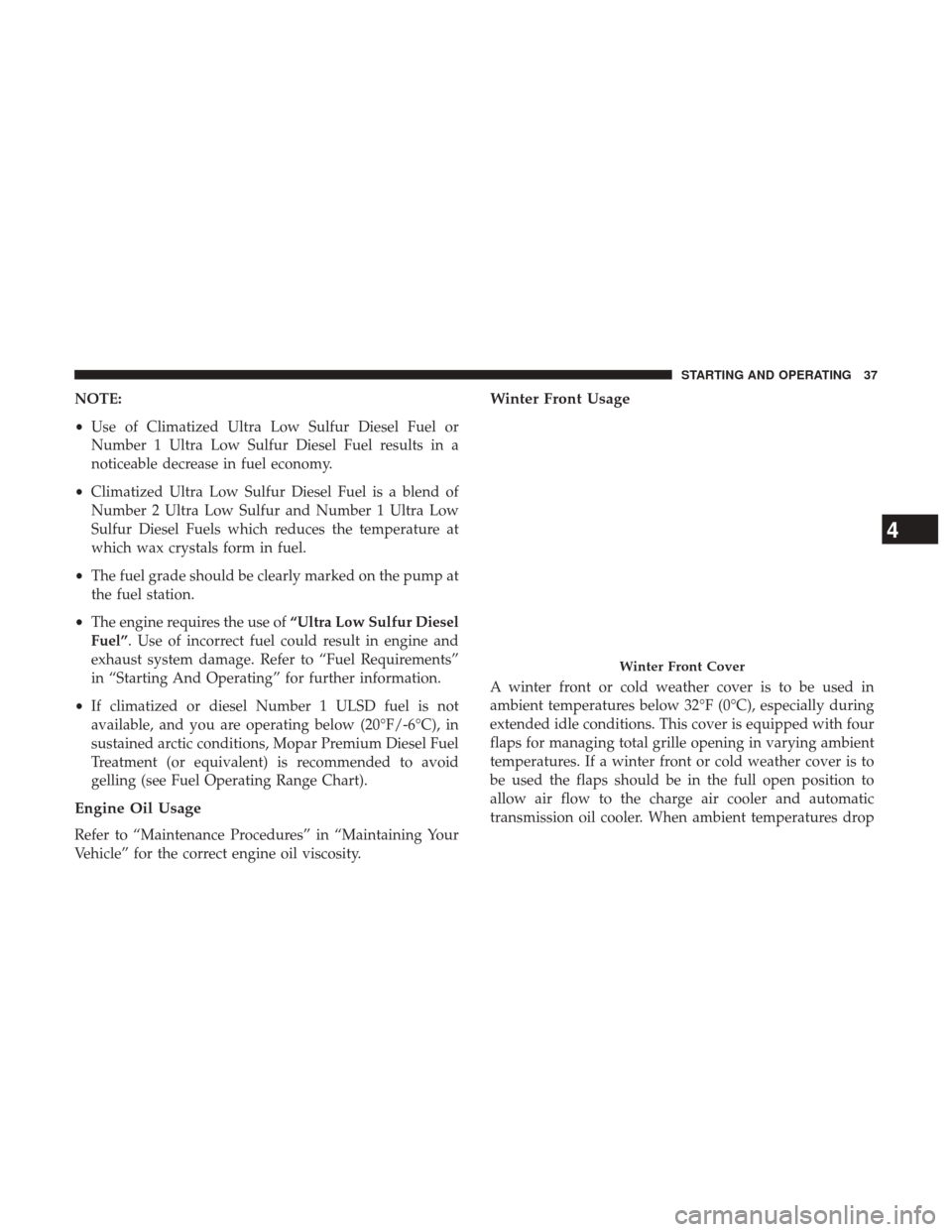
NOTE:
•Use of Climatized Ultra Low Sulfur Diesel Fuel or
Number 1 Ultra Low Sulfur Diesel Fuel results in a
noticeable decrease in fuel economy.
• Climatized Ultra Low Sulfur Diesel Fuel is a blend of
Number 2 Ultra Low Sulfur and Number 1 Ultra Low
Sulfur Diesel Fuels which reduces the temperature at
which wax crystals form in fuel.
• The fuel grade should be clearly marked on the pump at
the fuel station.
• The engine requires the use of “Ultra Low Sulfur Diesel
Fuel”. Use of incorrect fuel could result in engine and
exhaust system damage. Refer to “Fuel Requirements”
in “Starting And Operating” for further information.
• If climatized or diesel Number 1 ULSD fuel is not
available, and you are operating below (20°F/-6°C), in
sustained arctic conditions, Mopar Premium Diesel Fuel
Treatment (or equivalent) is recommended to avoid
gelling (see Fuel Operating Range Chart).
Engine Oil Usage
Refer to “Maintenance Procedures” in “Maintaining Your
Vehicle” for the correct engine oil viscosity.
Winter Front Usage
A winter front or cold weather cover is to be used in
ambient temperatures below 32°F (0°C), especially during
extended idle conditions. This cover is equipped with four
flaps for managing total grille opening in varying ambient
temperatures. If a winter front or cold weather cover is to
be used the flaps should be in the full open position to
allow air flow to the charge air cooler and automatic
transmission oil cooler. When ambient temperatures drop
Winter Front Cover
4
STARTING AND OPERATING 37
Page 41 of 228
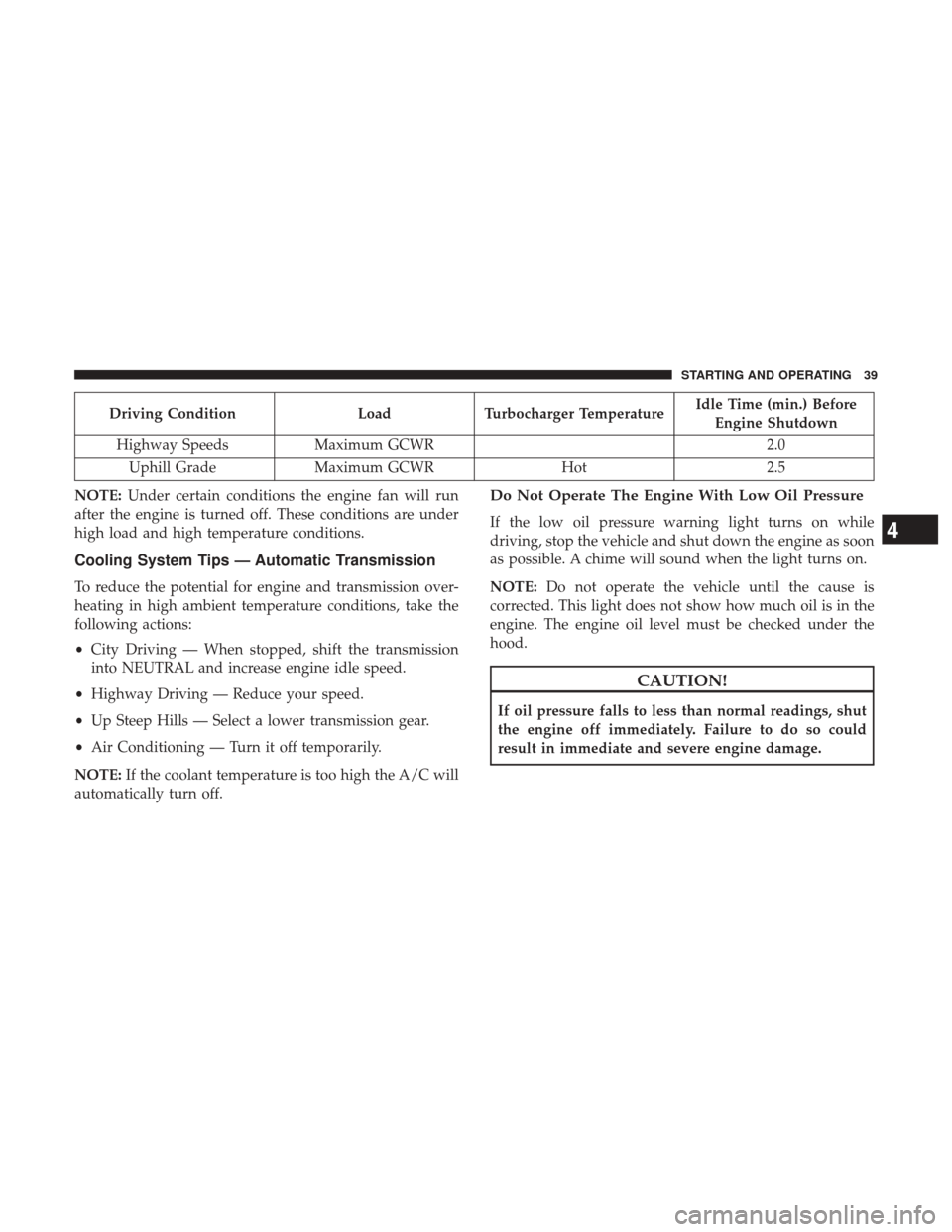
Driving ConditionLoadTurbocharger Temperature Idle Time (min.) Before
Engine Shutdown
Highway Speeds Maximum GCWR 2.0
Uphill Grade Maximum GCWR Hot2.5
NOTE: Under certain conditions the engine fan will run
after the engine is turned off. These conditions are under
high load and high temperature conditions.
Cooling System Tips — Automatic Transmission
To reduce the potential for engine and transmission over-
heating in high ambient temperature conditions, take the
following actions:
• City Driving — When stopped, shift the transmission
into NEUTRAL and increase engine idle speed.
• Highway Driving — Reduce your speed.
• Up Steep Hills — Select a lower transmission gear.
• Air Conditioning — Turn it off temporarily.
NOTE: If the coolant temperature is too high the A/C will
automatically turn off.
Do Not Operate The Engine With Low Oil Pressure
If the low oil pressure warning light turns on while
driving, stop the vehicle and shut down the engine as soon
as possible. A chime will sound when the light turns on.
NOTE: Do not operate the vehicle until the cause is
corrected. This light does not show how much oil is in the
engine. The engine oil level must be checked under the
hood.
CAUTION!
If oil pressure falls to less than normal readings, shut
the engine off immediately. Failure to do so could
result in immediate and severe engine damage.
4
STARTING AND OPERATING 39
Page 57 of 228
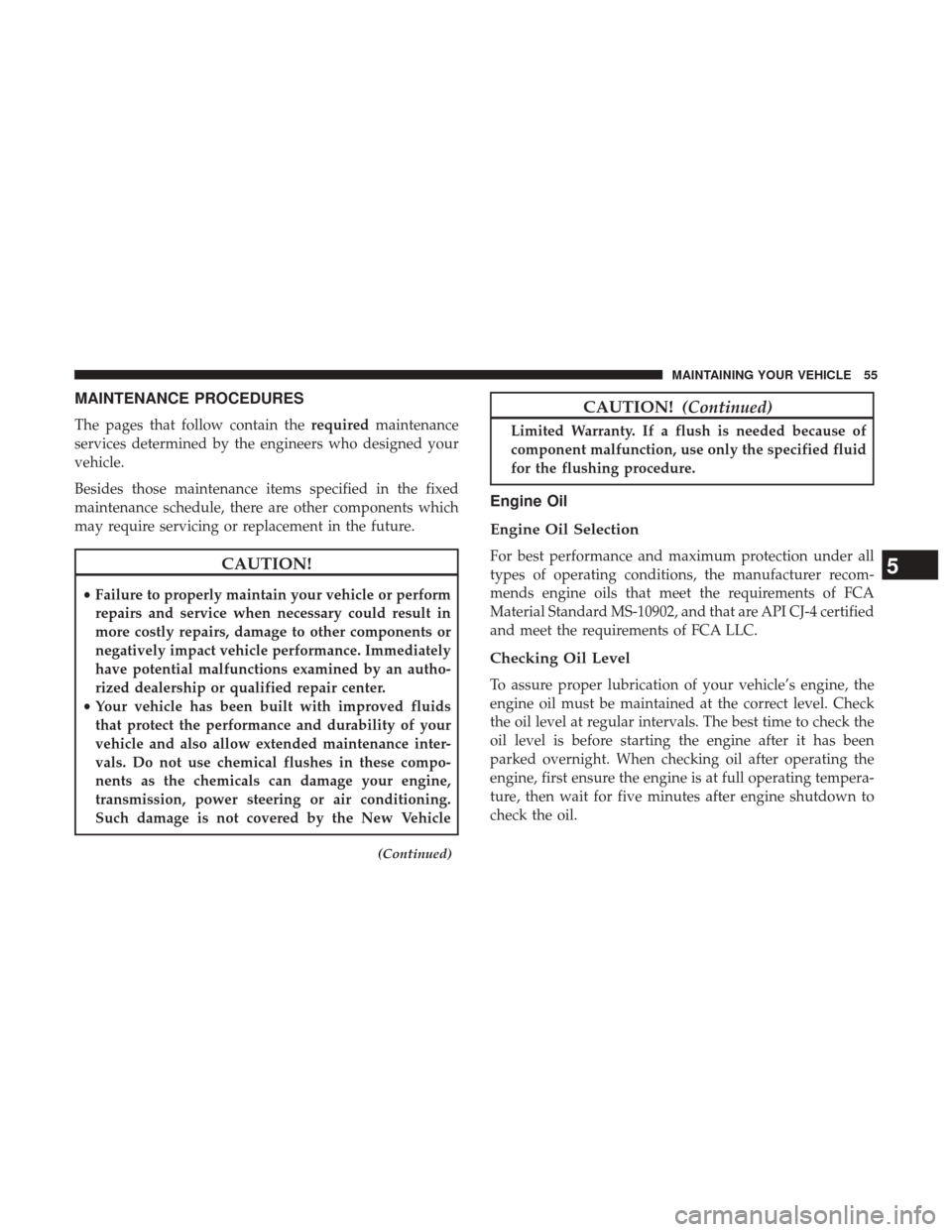
MAINTENANCE PROCEDURES
The pages that follow contain therequiredmaintenance
services determined by the engineers who designed your
vehicle.
Besides those maintenance items specified in the fixed
maintenance schedule, there are other components which
may require servicing or replacement in the future.
CAUTION!
• Failure to properly maintain your vehicle or perform
repairs and service when necessary could result in
more costly repairs, damage to other components or
negatively impact vehicle performance. Immediately
have potential malfunctions examined by an autho-
rized dealership or qualified repair center.
• Your vehicle has been built with improved fluids
that protect the performance and durability of your
vehicle and also allow extended maintenance inter-
vals. Do not use chemical flushes in these compo-
nents as the chemicals can damage your engine,
transmission, power steering or air conditioning.
Such damage is not covered by the New Vehicle
(Continued)
CAUTION! (Continued)
Limited Warranty. If a flush is needed because of
component malfunction, use only the specified fluid
for the flushing procedure.
Engine Oil
Engine Oil Selection
For best performance and maximum protection under all
types of operating conditions, the manufacturer recom-
mends engine oils that meet the requirements of FCA
Material Standard MS-10902, and that are API CJ-4 certified
and meet the requirements of FCA LLC.
Checking Oil Level
To assure proper lubrication of your vehicle’s engine, the
engine oil must be maintained at the correct level. Check
the oil level at regular intervals. The best time to check the
oil level is before starting the engine after it has been
parked overnight. When checking oil after operating the
engine, first ensure the engine is at full operating tempera-
ture, then wait for five minutes after engine shutdown to
check the oil.
5
MAINTAINING YOUR VEHICLE 55
Page 96 of 228
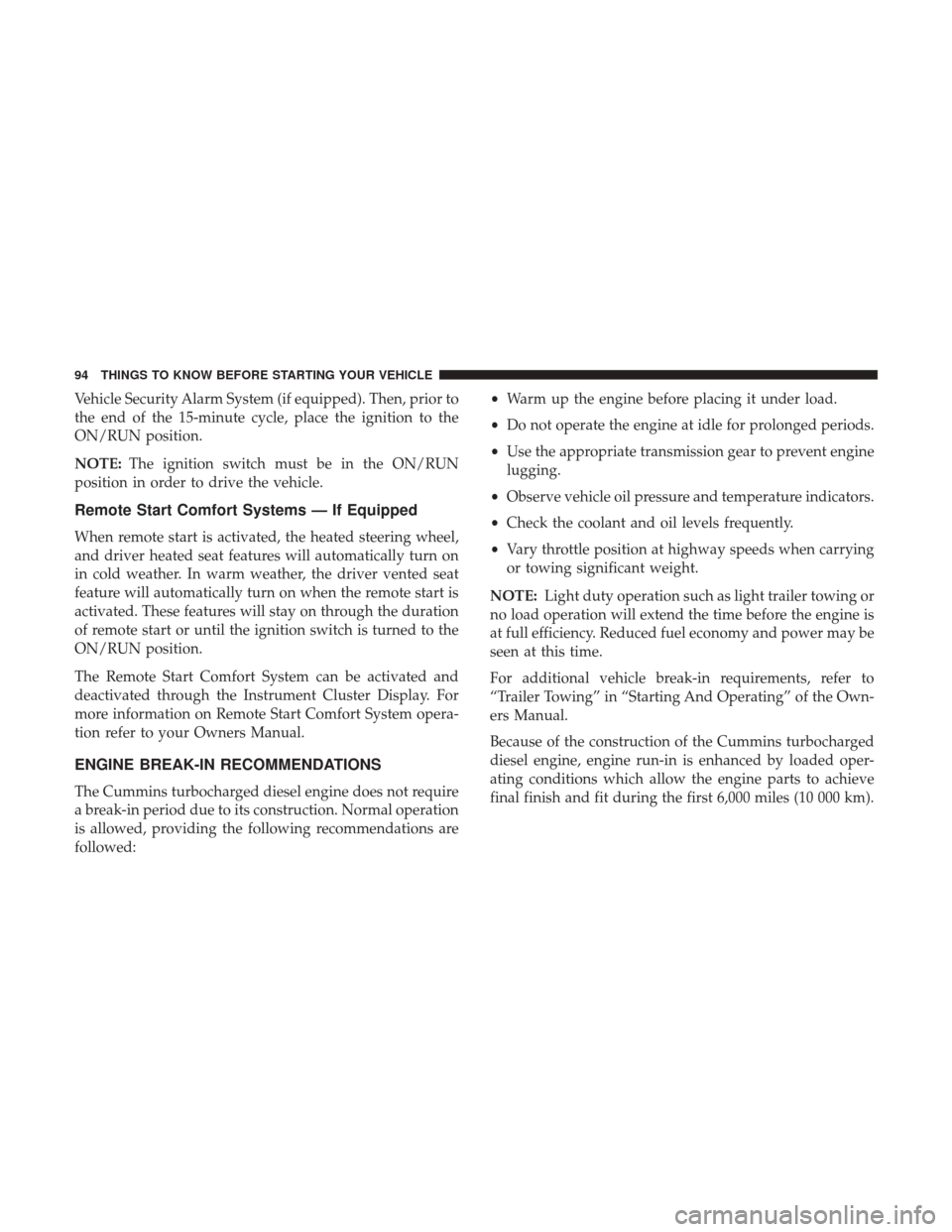
Vehicle Security Alarm System (if equipped). Then, prior to
the end of the 15-minute cycle, place the ignition to the
ON/RUN position.
NOTE:The ignition switch must be in the ON/RUN
position in order to drive the vehicle.
Remote Start Comfort Systems — If Equipped
When remote start is activated, the heated steering wheel,
and driver heated seat features will automatically turn on
in cold weather. In warm weather, the driver vented seat
feature will automatically turn on when the remote start is
activated. These features will stay on through the duration
of remote start or until the ignition switch is turned to the
ON/RUN position.
The Remote Start Comfort System can be activated and
deactivated through the Instrument Cluster Display. For
more information on Remote Start Comfort System opera-
tion refer to your Owners Manual.
ENGINE BREAK-IN RECOMMENDATIONS
The Cummins turbocharged diesel engine does not require
a break-in period due to its construction. Normal operation
is allowed, providing the following recommendations are
followed: •
Warm up the engine before placing it under load.
• Do not operate the engine at idle for prolonged periods.
• Use the appropriate transmission gear to prevent engine
lugging.
• Observe vehicle oil pressure and temperature indicators.
• Check the coolant and oil levels frequently.
• Vary throttle position at highway speeds when carrying
or towing significant weight.
NOTE: Light duty operation such as light trailer towing or
no load operation will extend the time before the engine is
at full efficiency. Reduced fuel economy and power may be
seen at this time.
For additional vehicle break-in requirements, refer to
“Trailer Towing” in “Starting And Operating” of the Own-
ers Manual.
Because of the construction of the Cummins turbocharged
diesel engine, engine run-in is enhanced by loaded oper-
ating conditions which allow the engine parts to achieve
final finish and fit during the first 6,000 miles (10 000 km).
94 THINGS TO KNOW BEFORE STARTING YOUR VEHICLE
Page 128 of 228

Normal Starting Procedure — Engine Manifold Air
Temperature Above 66° F (19° C)
Observe the instrument panel cluster lights when starting
the engine.
1. Always apply the parking brake.
2. Shift into PARK for an automatic transmission.For vehicles equipped with a manual transmission, fully
press and hold the clutch pedal and shift into NEU-
TRAL.
3. Turn the ignition switch to the ON position and watch the instrument panel cluster lights.
CAUTION!
If the “Water in Fuel Indicator Light” remains on, DO
NOT START the engine before you drain the water
from the fuel filters to avoid engine damage. Refer to
“Maintenance Procedures/Draining Fuel/Water Sepa-
rator Filter” in “Maintaining Your Vehicle” for further
information. 4. Turn the ignition switch to the START position and
crank the engine. Do not press the accelerator during
starting.
CAUTION!
Do not crank engine for more than 15 seconds at a time
or starter motor damage may result. Turn the ignition
switch to the OFF position and wait at least two
minutes for the starter to cool before repeating start
procedure.
5. When the engine starts, release the key fob.
6. Check that the oil pressure warning light has turned off.
7. Release the parking brake.
Starting Procedure — Engine Manifold Air
Temperature 0°F To 66°F (–18°C to 19°C)
NOTE: The temperature displayed in the instrument clus-
ter does not necessarily reflect the engine manifold air
temperature. Refer to “Instrument Cluster Display” in
“Understanding Your Instrument Panel” for further infor-
mation. When engine temperatures fall below 66°F (19°C)
the “Wait To Start Light” will remain on indicating the
intake manifold heater system is active.
126 STARTING AND OPERATING
Page 134 of 228
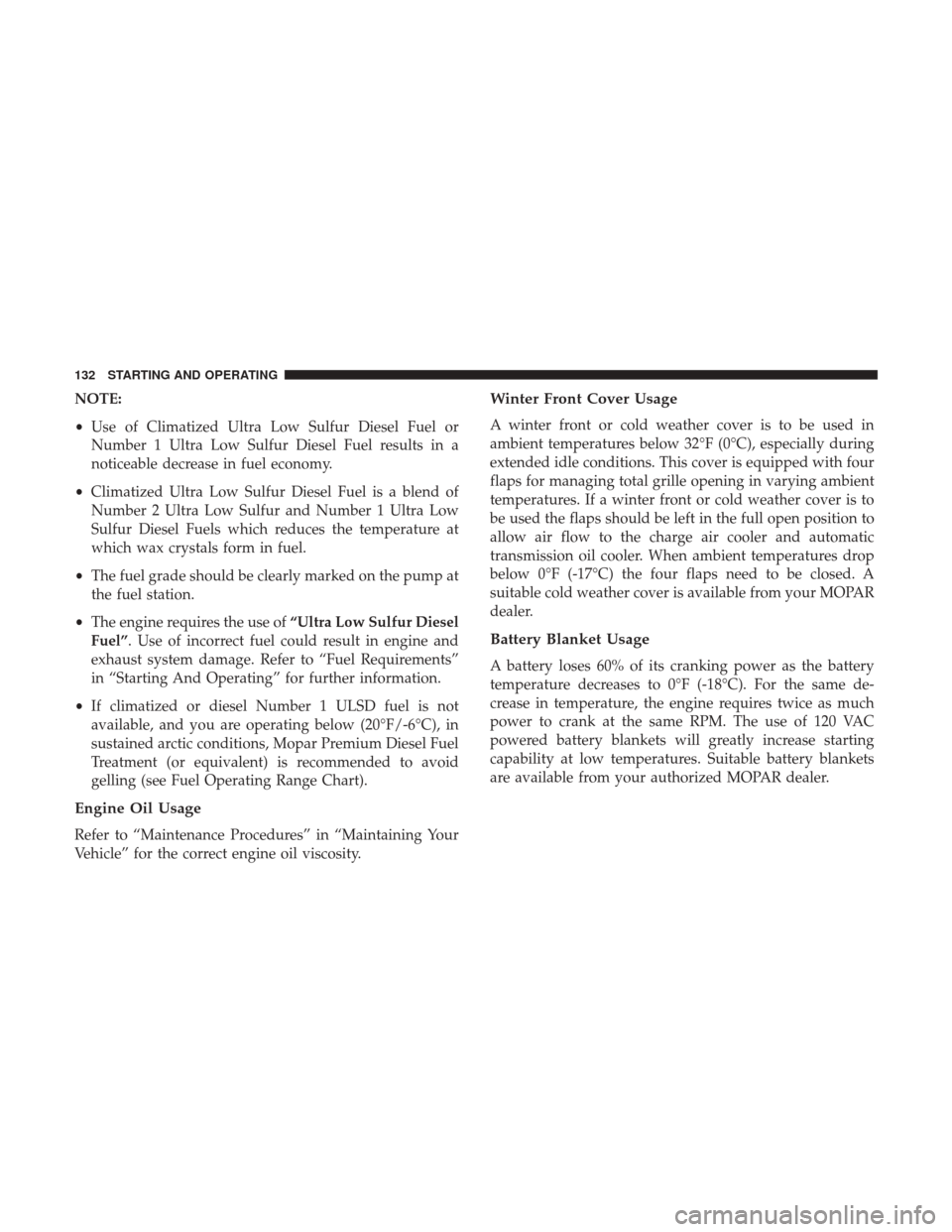
NOTE:
•Use of Climatized Ultra Low Sulfur Diesel Fuel or
Number 1 Ultra Low Sulfur Diesel Fuel results in a
noticeable decrease in fuel economy.
• Climatized Ultra Low Sulfur Diesel Fuel is a blend of
Number 2 Ultra Low Sulfur and Number 1 Ultra Low
Sulfur Diesel Fuels which reduces the temperature at
which wax crystals form in fuel.
• The fuel grade should be clearly marked on the pump at
the fuel station.
• The engine requires the use of “Ultra Low Sulfur Diesel
Fuel”. Use of incorrect fuel could result in engine and
exhaust system damage. Refer to “Fuel Requirements”
in “Starting And Operating” for further information.
• If climatized or diesel Number 1 ULSD fuel is not
available, and you are operating below (20°F/-6°C), in
sustained arctic conditions, Mopar Premium Diesel Fuel
Treatment (or equivalent) is recommended to avoid
gelling (see Fuel Operating Range Chart).
Engine Oil Usage
Refer to “Maintenance Procedures” in “Maintaining Your
Vehicle” for the correct engine oil viscosity.
Winter Front Cover Usage
A winter front or cold weather cover is to be used in
ambient temperatures below 32°F (0°C), especially during
extended idle conditions. This cover is equipped with four
flaps for managing total grille opening in varying ambient
temperatures. If a winter front or cold weather cover is to
be used the flaps should be left in the full open position to
allow air flow to the charge air cooler and automatic
transmission oil cooler. When ambient temperatures drop
below 0°F (-17°C) the four flaps need to be closed. A
suitable cold weather cover is available from your MOPAR
dealer.
Battery Blanket Usage
A battery loses 60% of its cranking power as the battery
temperature decreases to 0°F (-18°C). For the same de-
crease in temperature, the engine requires twice as much
power to crank at the same RPM. The use of 120 VAC
powered battery blankets will greatly increase starting
capability at low temperatures. Suitable battery blankets
are available from your authorized MOPAR dealer.
132 STARTING AND OPERATING
Page 135 of 228
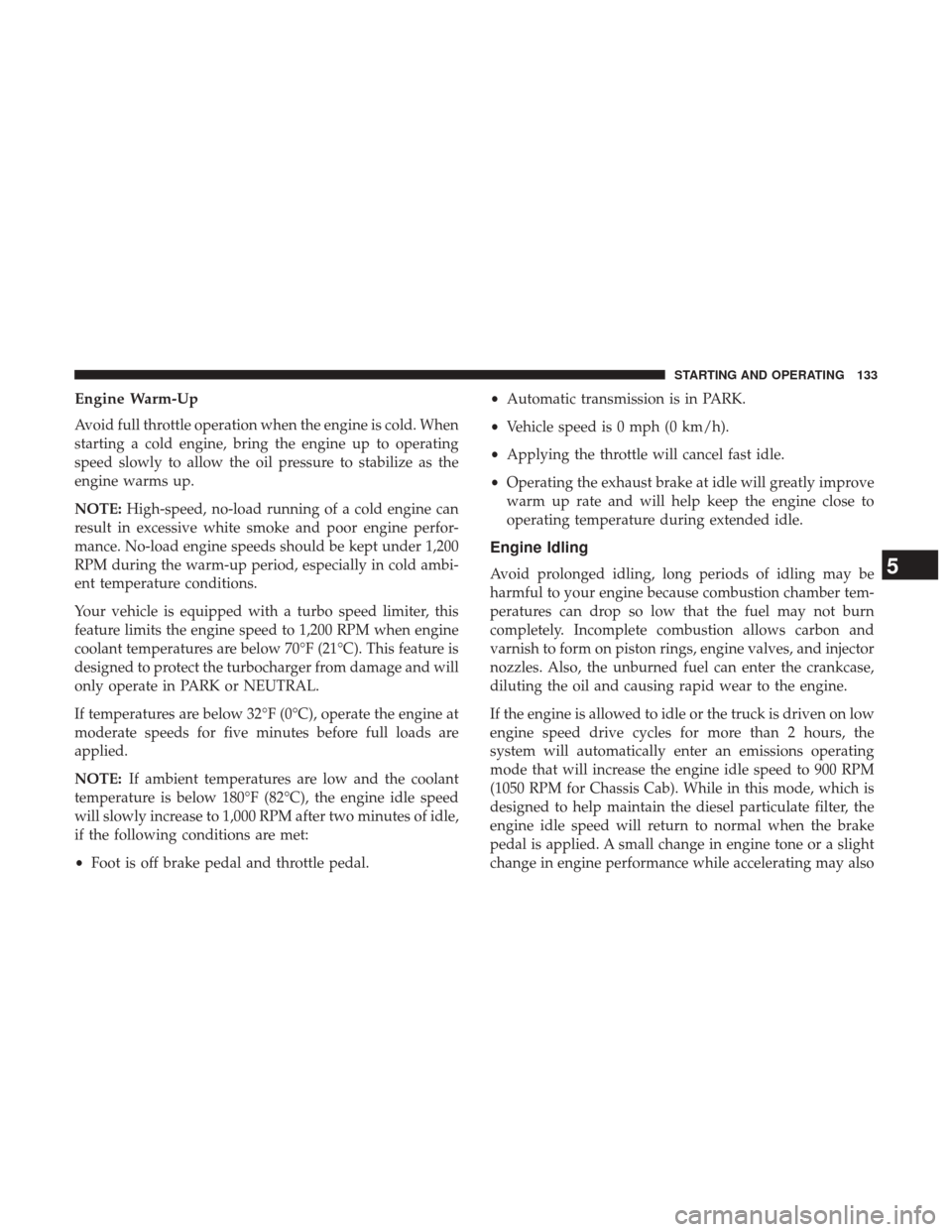
Engine Warm-Up
Avoid full throttle operation when the engine is cold. When
starting a cold engine, bring the engine up to operating
speed slowly to allow the oil pressure to stabilize as the
engine warms up.
NOTE:High-speed, no-load running of a cold engine can
result in excessive white smoke and poor engine perfor-
mance. No-load engine speeds should be kept under 1,200
RPM during the warm-up period, especially in cold ambi-
ent temperature conditions.
Your vehicle is equipped with a turbo speed limiter, this
feature limits the engine speed to 1,200 RPM when engine
coolant temperatures are below 70°F (21°C). This feature is
designed to protect the turbocharger from damage and will
only operate in PARK or NEUTRAL.
If temperatures are below 32°F (0°C), operate the engine at
moderate speeds for five minutes before full loads are
applied.
NOTE: If ambient temperatures are low and the coolant
temperature is below 180°F (82°C), the engine idle speed
will slowly increase to 1,000 RPM after two minutes of idle,
if the following conditions are met:
• Foot is off brake pedal and throttle pedal. •
Automatic transmission is in PARK.
• Vehicle speed is 0 mph (0 km/h).
• Applying the throttle will cancel fast idle.
• Operating the exhaust brake at idle will greatly improve
warm up rate and will help keep the engine close to
operating temperature during extended idle.
Engine Idling
Avoid prolonged idling, long periods of idling may be
harmful to your engine because combustion chamber tem-
peratures can drop so low that the fuel may not burn
completely. Incomplete combustion allows carbon and
varnish to form on piston rings, engine valves, and injector
nozzles. Also, the unburned fuel can enter the crankcase,
diluting the oil and causing rapid wear to the engine.
If the engine is allowed to idle or the truck is driven on low
engine speed drive cycles for more than 2 hours, the
system will automatically enter an emissions operating
mode that will increase the engine idle speed to 900 RPM
(1050 RPM for Chassis Cab). While in this mode, which is
designed to help maintain the diesel particulate filter, the
engine idle speed will return to normal when the brake
pedal is applied. A small change in engine tone or a slight
change in engine performance while accelerating may also5
STARTING AND OPERATING 133
Page 136 of 228

be noticeable at speeds below 20 mph (32 kmh). This
operating mode may last for up to an hour of idle time, or
around 20 minutes of driving time.
Your truck may have been ordered with an optional
voltage monitoring idle up feature. If a load is placed on
the electrical system while the truck is in park, this feature
will attempt to maintain normal system voltage by auto-
matically increasing engine idle speed. You may notice
several consecutive increases in idle speed, up to a maxi-
mum of 1450 RPM, as the system will attempt to utilize the
smallest increase in idle speed necessary to maintain
normal system voltage. The idle speed will return to
normal when either the electrical load is removed, or when
the brake pedal is applied.
NOTE:For instrument cluster display messages related to
the vehicle’s exhaust system, refer to “Instrument Cluster
Display” in “Understanding Your Instrument Panel” for
further information.
Idle-Up Feature — Automatic Transmission Only
The driver-controlled high idle speed feature will help
increase cylinder temperatures and provide additional cab
heat, however, excessive idling may still cause the exhaust
aftertreatment system to not properly regenerate. Extended
periods of idle time should be avoided. The Idle-Up feature uses the speed control switches to
increase engine idle speed and quickly warm the vehicle’s
interior.
1. With the transmission in PARK, the parking brake
applied, and the engine running, push the speed control
switch to the ON position, then push the SET switch.
2. The engine RPM will go up to 1100 RPM. To increase the RPM, push and hold the ACCEL/RESUME switch and
the idle speed will increase to approximately 1500 RPM.
To decrease the RPM, push and hold the DECEL switch
and the idle speed will decrease to approximately
1100 RPM.
3. To cancel the Idle–Up feature, either push the CANCEL switch, push the ON/OFF switch, or press the brake
pedal.
Stopping The Engine
Idle the engine a few minutes before routine shutdown.
After full load operation, idle the engine three to five
minutes before shutting it down. This idle period will
allow the lubricating oil and coolant to carry excess heat
away from the combustion chamber, bearings, internal
components, and turbocharger. This is especially important
for turbocharged, charge air-cooled engines.
134 STARTING AND OPERATING